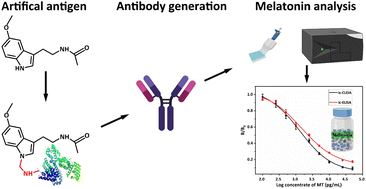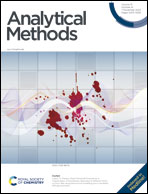Development of indirect competitive ELISA and CLEIA for quantitative analysis of melatonin in health products†
Abstract
Melatonin (MT), as a hormone regulating the rhythm of sleep, is widely used in health products. However, illicit and excessive use of MT might cause undesirable effects. Therefore, it is essential to establish highly sensitive and specific rapid methods for MT analysis in health products. In this study, we established indirect competitive enzyme-linked immunosorbent assay (ic-ELISA) and indirect competitive chemiluminescent enzyme immunoassay (ic-CLEIA) for sensitive and selective detection of MT in health products. Under optimal conditions, half-maximum inhibitory concentration (IC50 value) and limit of detection (LOD, IC10 value) for MT by ic-ELISA were 0.25 ng mL−1 and 0.03 ng mL−1 respectively, while the IC50 and LOD of ic-CLEIA were lower at 0.17 ng mL−1 and 0.03 ng mL−1 respectively. Three MT-free Chinese patent medicines were spiked with MT and the recovery rates ranged from 71.89% to 117% (ic-ELISA) and 83.66% to 107.17% (ic-CLEIA). The level of MT in six MT-containing health products was assessed in parallel using the developed methods and HPLC. Both ic-ELISA and ic-CLEIA showed good consistencies (R2 = 0.999 and 0.993, respectively) with HPLC, indicating that the two methods developed were sensitive, fast, and reliable for application in MT analysis.



 Please wait while we load your content...
Please wait while we load your content...